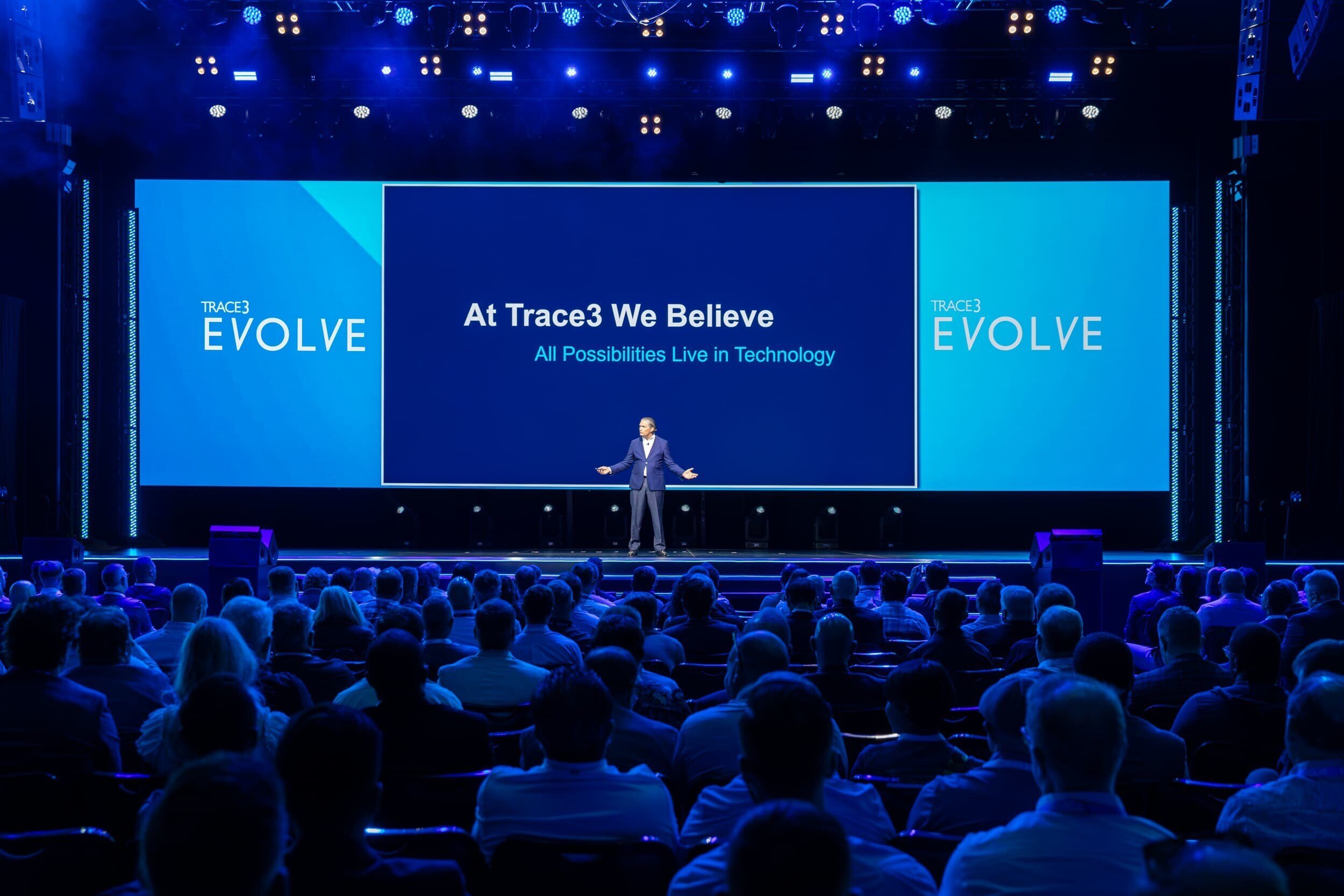Maximize Talent, Minimize Turnover: Trace3’s Approach to Upskilling AI Literacy
The lure of AI is irresistible, especially for large enterprises aiming to stay ahead of the curve in today’s highly competitive environment. However, the rush to exploit its power for productivity gains is often accompanied by significant workforce disruption and dissatisfaction. These cycles of employee turnover are risky, as the successful adoption of AI demands a human workforce aligned with its goals. Trace3, a leading IT and AI solutions provider, contends that investing in AI training is key to this conundrum.
(Irvine, CA) August 08, 2024 — American companies across all sectors are experiencing a rollercoaster ride in their adoption of AI. One day, they find a cost-saving opportunity in generative language models or machine learning, only to scramble to hire experts to tame these tools the next. Jobs essentially becoming turnstiles have had a hard impact on employee morale, potentially negating the increased productivity and innovation delivered by AI. “Instead of responding to AI disruptions by reshuffling headcount, companies should pre-empt these changes by reskilling and upskilling their existing resources,” points out Justin Hutchens Innovation Principal of Trace3. “Equipping your employees with the tools to adapt to the evolving AI landscape is key to fostering a confident and loyal team.”
Winners and losers of the AI revolution
AI applications have completely upended the global job market. On one hand, AI has improved how employees handle complex tasks. For example, healthcare professionals can enhance their diagnosis with imaging solutions while software developers can count on tools to write code. On the other hand, AI has displaced routine tasks, including significant portions of customer service and data entry. As a result, the job market is in a state of flux, with both substantial job displacement and job creation.
The latest World Economic Forum report forecasts a net job loss of 14 million by 2027, with 83 million positions eliminated and 69 million new ones created. (1) In the US, nearly 12 million workers are expected to need new employment by 2030. (2) A McKinsey report claims that simple manual labor and basic data processing will be the most susceptible to the AI revolution, while management and jobs requiring applied “expertise” will be the least impacted. (3) In short, only the scarcer, higher-paying roles can expect some degree of job security in the near future.
However, even the winners of this seismic shift are not resting on their laurels. A survey conducted by the American Psychological Association claims that 38% of US workers are worried that AI could eventually take their jobs. Among these, 51% report work-induced mental duress, and 46% are considering seeking new employment. (4)
“Employees are on edge these days,” says Hutchens. “Companies need to be judicious in their adoption of AI; sweeping, abrupt decisions have shown to turn remaining employees into discontented mercenaries.”
Growing with AI
AI puts businesses in a difficult position. Its ability to quickly increase productivity — sometimes at small to no financial cost — makes it extremely difficult to resist; 72% of US companies have already incorporated AI, and the remaining are almost certainly exploring its use cases. (5) But the ensuing cycles of restructuring and employee churn can foment resentment in the company.
Helping employees gain the skills to harness AI presents itself as the ideal solution. This option provides several advantages.
- Cost-efficiency: Upskilling existing employees is approximately seven times more cost-effective than replacing redundant employees with new, AI-proficient hires. (7)
- Proficiency: A company with an AI-trained workforce gains a competitive edge over those without such training. For example, a recent study by MIT revealed that while generative AI can boost productivity by 38%, providing employees with a short tutorial yielded an additional 4% increase. (6)
- Trust: Guided upskilling fosters trust, which reduces turnover and may inspire employees to exceed expectations. A survey found that 57% want companies to provide them with AI training. (8)
- Security: With the proper guidance, employees can wield AI without jeopardizing privacy and confidentiality. A clear understanding of AI’s limitations prevents overreliance and ensures responsible use.
“This is the path we’ve chosen at Trace3,” says Justin “Hutch” Hutchens, Innovation Principal. “We prepare our workforce for AI-driven roles by providing theoretical and hands-on training and data literacy workshops. Our program is customized to the roles in our organization, so both technical and non-technical employees can become AI experts in their respective domains.”
Navigating uncharted territory
However, AI literacy programs are not always easy to implement, especially in large enterprises with huge workforces. Only 38% of US executives have attempted it — often with mixed results. (9)
For one, building such programs requires advanced data science expertise, a scarce resource for many organizations. Even companies that do possess the technical know-how may lack the pedagogical experience necessary to transfer this knowledge to their workforce. Furthermore, there is also the challenge of integrating AI tools with existing systems. Talking to ChatGPT is merely the tip of the iceberg.
Partnering with a business transformation consultancy may just be what companies need to get their employees acquainted with AI. Beyond their experience in data-centric education, these firms can help other organizations implement and manage AI solutions while adhering to rigorous governance, compliance, and ethical standards.
“We at Trace3 talk a great deal about providing strategic AI guidance and implementation, but we walk the walk, too,” says Hutch. “We’ve recently launched our own internal AI training program, ‘AI Legends,’ developed in collaboration with Udemy. We’ve then tabulated our results piloting this program and compared notes with other tech leaders that have rolled out similar initiatives.”
Ultimately, effective utilization of AI hinges on a company’s ability to cultivate a workforce adept at navigating the technology’s complexities. Such is the new foundation for sustainable growth and success.
About Trace3:
Today there is a great deal of noise in the technology industry around AI, but not much practical intelligence is offered. Trace3, based in Irvine, California, delivers over 20 years of expertise in delivering innovation in the form of emerging technology, providing unique technology solutions and consulting services to change this – and drive its implementation across enterprises. Their elite engineering and dynamic innovation provide convergent solutions that embrace emerging technology and drive measurable value. Trace3 embodies the spirit of a startup with the advantage of a scalable business. Trace3 believes that ALL Possibilities Live in AI. For more information, visit www.trace3.com.
References:
- World Economic Forum. “Future of Jobs Report 2023: Up to a Quarter of Jobs Expected to Change in Next Five Years.” World Economic Forum, weforum.org/press/2023/04/future-of-jobs-report-2023-up-to-a-quarter-of-jobs-expected-to-change-in-next-five-years/. Accessed 30 July 2024.
- Zinkula, Jacob, Aaron Monk. “ChatGPT may be coming for our jobs. Here are the 10 roles that AI is most likely to replace.” Business Insider, businessinsider.com/chatgpt-jobs-at-risk-replacement-artificial-intelligence-ai-labor-trends-2023-02. Accessed 30 July 2024.
- Manyika, Von James et al. “A future that works: Automation, employment, and productivity.” McKinsey Global Institute, mckinsey.com/featured-insights/digital-disruption/harnessing-automation-for-a-future-that-works/de-DE. Accessed 30 July 2024.
- Lerner, Michele. “Worried about AI in the workplace? You’re not alone.” American Psychological Association, apa.org/topics/healthy-workplaces/artificial-intelligence-workplace-worry. Accessed 30 July 2024.
- Chui, Michael et al. “The state of AI in 2023: Generative AI’s breakout year.” McKinsey, mckinsey.com/capabilities/quantumblack/our-insights/the-state-of-ai-in-2023-generative-ais-breakout-year. Accessed 31 July 2024.
- Somers, Meredith. “How generative AI can boost highly skilled workers’ productivity.” MIT, mitsloan.mit.edu/ideas-made-to-matter/how-generative-ai-can-boost-highly-skilled-workers-productivity. Accessed 31 July 2024.
- Machuel, Denis. “Why investing in talent can pull us through a polycrisis.” World Economics Forum, weforum.org/agenda/2023/01/davos23-invest-in-talent-future-of-work-polycrisis/. Accessed July 31 2024.
- Machuel, Denis. “A majority of workers want AI training from their companies. We must empower them.” World Economic Forum, weforum.org/agenda/2024/01/ai-training-workforce/. Accessed 31 July 2024.
- Liu, Jennifer. “Executives are spending on AI – but just 38% are actually training workers on it.” CNBC, cnbc.com/2024/03/06/linkedin-just-38percent-of-employers-provide-ai-training-to-workers.html. Accessed 31 July 2024.
###
Media Inquiries:
Karla Jo Helms
JOTO PR™
727-777-4619
jotopr.com
You May Also Like
These Related Stories

Sidestepping AI's Pitfalls: The Unforeseen Implementation Risks

Evolve Technology Conference to Address $38.9B AI Market's Impact on FinServ


No Comments Yet
Let us know what you think